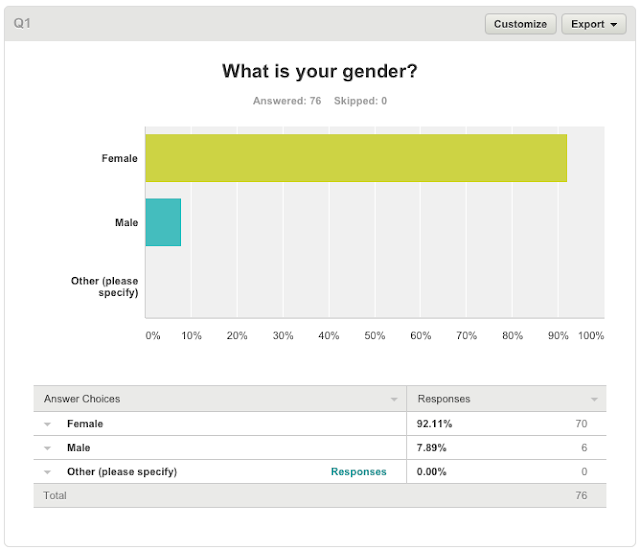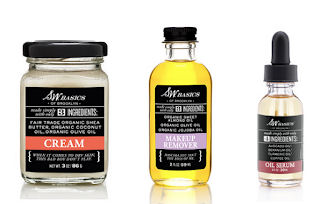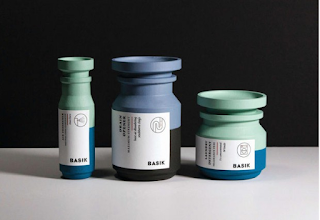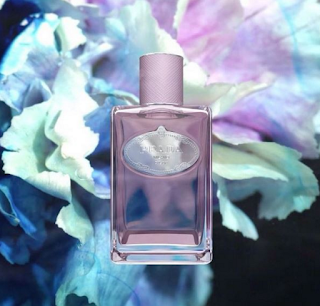Survey results
Home » November 2015
Gender Neutral Cosmetics
Source: http://www.nellyrodilab.com/en/beauty-en/gender-neutral-cosmetics.html
S.W Basics of Brooklyn
This brand applies this strategy to promote an identity that’s strongly inspired by the food sector, with creams, scrubs, cleansers, hibiscus masks, and organic lip balms. Every one of its products meets the requirement of “less and better” containing only essential ingredients, and no mention of sex.
Analysis
The branding for these cosmetics appear neutral and not suggesting they are for any particular gender. The bottles resemble a victorian influence whilst the branding is kept simple and not over the top. The colours representing what the product is do not suggest that it should be used by either a male or female, however the use of three different fonts throughout the brand appears unorganised and cluttered. The simplicity of the layout and colours used are the strong elements to the aesthetic however the type lets the brand down as its not always legible.
The branding for these cosmetics appear neutral and not suggesting they are for any particular gender. The bottles resemble a victorian influence whilst the branding is kept simple and not over the top. The colours representing what the product is do not suggest that it should be used by either a male or female, however the use of three different fonts throughout the brand appears unorganised and cluttered. The simplicity of the layout and colours used are the strong elements to the aesthetic however the type lets the brand down as its not always legible.
Saana Hellsten: Basik
In her thesis on gender, Finnish graphic artist Saana Hellsten postulated that the only real difference between men’s and women’s razors was their color (blue vs pink). To eliminate these clichés, she developed “Basik”, a packaging line with gender-neutral graphics that focus on the product’s function rather than the sex it is intended for.
Analysis
This is a good example of a cosmetic brand that has been stripped down and built up from a neutral perspective. The simplicity of the layout and type reflect a more neutral tone of voice and do not appear to communicate to a certain audience. This is something I would like to take note on for when it comes to the practical side of my dissertation. The colours however I think could be improved, the pastel and bold theme has potential but I do not think the colours used work at reflecting the product as a cosmetic and looks more like something medicinal.
MAKE
NYC beauty brand MAKE is known for its paraben-free products made locally. It recently launched “Naxos”, a gender-neutral product range initially with two products: lip oil and an anti-blue light primer that protects the skin from the invisible light rays emitted by computers, cell phones, etc. The brand has also done collaborations with designers like Faye Toogood, a fervent “No Gender” partisan who expresses her philosophy through her eponymous clothing line.
Analysis
This brand appears a lot more simple and minimal. There are no labels on the containers giving a more translucent look to the product which could signify the brand itself and how its a clean and neutral it is with no added chemicals or stereotypical representations of gender. The type however contradicts with what I've just said as it appears to me as 'feminine'. This is a matter of opinion but the elongated type signifies a more elegant and delicate element which does not appear to be on a neutral level.
Context
Context applies the same philosophy to its—unisex—products, which capitalise on their formulas using powerful antioxidants, vegetable oils and natural plant extracts.
Analysis
This again is another example of a gender neutral brand. With the minimalistic aesthetic of the brand it keeps a neutral tone of voice and doesn't communicate a certain gender or sex. Although the minimal theme works well, I cannot help but think that a store full of these cosmetics would appear dull. As I believe we are in the first steps of neutralising cosmetics, the branding part isn't exactly strong yet and isn't pushing the boundaries on neutral brand aesthetics. The minimalistic structure however is something I am taking on board for my practical work, I believe its a good approach at representing these brands from a neutral level.
Prada
These days, the gender-neutral question is also attracting the attention of luxury players who see this new offer as the ideal way of addressing a broader target while advocating values in line with the times. Prada is an excellent example; the Italian designer has launched unisex infusions, a collection of six fragrances that celebrate the gender-free lifestyle, and satisfy new consumer demands.
Analysis
Gender Neutral Brand: Sam Farmer
Sam was someone I decided to contact after researching into gender neutral cosmetics. He pointed me to his blog which he updates weekly on his experience with gendered cosmetics and what influence him into creating his own gender neutral brand. It's interesting to see his analysis on gendered branding as its something that has affected him more personally. Describing his experience with his children, and how when they came into their teens they required cosmetics such as deodorants and cleansers. To his horror he says he was disgusted in the separation of aisles and what was targeted at boys and girls, his main focus was the branding of these cosmetics and what they suggested to the audience. The images he used supported this argument as you can see the difference in the tone of voice the cosmetics were communicating; 'Play it sexy', 'Kiss me' and 'Tease' all addressed the female target audience whereas the males were communicated with 'Full control', 'Team force' and 'Extreme power'. These were the brands he was pointing out as he did not agree with how teens were being communicated with and the branding of the cosmetics that was available to them. Again this relates to my theme topic for my investigation on why cosmetics are branded in this way and what does it tell about ourselves. It relates to my research into the construction of genders within advertising and how males and females are influenced to present themselves in western society.
Primary research - Existing gendered cosmetic brands
To start out my primary research I visited Boots to get an idea of gendered branding and how it applies to its target audience. My investigation was to look at cosmetic branding and analyse whether it is targeted to males or females, from previous research I have found that there isn't that much difference in the science behind the cosmetics and that they work on both genders. The smells however are different for males and females, this could potentially influence the individual to purchase the cosmetic. My aim however is to debunk gendered branding and look into why cosmetics have been branded for either male, female or both.
Above are examples of cosmetics that have been branded for females. It is a matter of opinion whether males or females would purchase this for themselves but from my analysis the branding looks like it is more targeted at females. The use of soft pastel colours, script and serifs type would signify a more elegant and feminine aesthetic. Why this applies to women could relate to the research I have gathered from gendered advertising and the construction of genders in western society.
On the contrary the branding for men is something I expected; almost the exact opposite aesthetic to female branding. The use of dark, metallic colours signify something more mechanical and harsh, the type too is mainly a bold san serif font, which represents strength and assertiveness. As though to suggest men must use these products in order to fulfil their roles as a man in society. Again this is a matter of opinion to the individual as some would argue the branding does not apply to them on choosing a cosmetic, however the branding is a good representation on who their target audience applies to. However this refers again to the research I collected for gendered advertising and how the roles of gender have been presented, it relates to cosmetic branding and how it also constructs gender in ways to influence individuals on how they should present themselves.
More examples of cosmetics that were placed right next to each other but targeted at different audiences. There is a distinct difference in the way the products have been branded, yes they may smell different but both do the same job. The comparison between the two products are obvious, soft pastel brand for women and a bold, more mechanical branding for males. This suggests the theory on the fragility of masculinity, where men need their own branded products that differ from female products to ensure they fulfil the role of being a 'man'.
Focusing on the placement and visuals of the shelves, there still appears to be a distinct difference in the was cosmetics have been branded for males and females. However the soap and glory aisle is a little biased as it only features one brand, but the point is that female brands appear to almost dominate the cosmetic side of the store. The branding is distinctly different as it applies to different audiences even though the majority of products do the same job.
I decided to watch The Codes of Gender as I thought it would be relevant research for the first chapter of my dissertation. As my focus was identity construction within society this documentary helped me get a better understanding of how femininity and masculinity have been presented in advertising.
Sut Jhally, a communications professor focus's on Erving Goffman's investigation on advertising and the way gender identity has been presented in different forms of media. Below are my notes from the documentary in which I found were the key points to acknowledge and get a better understanding of to write about in my chapter.
'To recognise someone as male or female is absolutely fundamental to our ability to interact with them.'
'Androginist people pose a challenge to the cultural system that is dependent upon those categories being clear'
'Goffman argues there is nothing natural with gender identity'
Sex - Different biological characteristics at birth
Gender - The cultural definitions given to the physical differences
Categories in western culture
Male Female
Strong Dependent
Intelligent Emotional
Competitive Empathetic
Masculine Feminine
'These traits are made sense of through the categories of culture'
'We learn to inhabit the gender category that we have been assigned from outside from the culture'
Some cultures recognise a third sex -> Middle Sex
- Indian sub continent, theres a whole class of people called Heshra (Could not find real name on google) who are neither male or female, but a third intersex category. Close to a million.
- Ideas and attitudes about gender are shaped by the culture and society that we grew up in.
- Western culture usually operates with a two sex two gender distinction.
- Gender Display: The process whereby we perform the roles expected of up by social convention.
Goffman - Advertising is a form of commercial realism which is trying to present the world in ways it could be real.
The way hands are presented in advertising as male or female. Goffman argues that female hands have a different relationship to male hands.
Feminine hands
- Letting the environment control them - not assertive
- Resting
- Caressing
- Cradling
- Holding things with the ends of fingers
Masculine hands
- Powerful
- Assertive
- Moulding to their environment
- Commanding
- Firm
Goffman also argues it is rare to find themselves in the same way women do.
Images that suggest fragility, softness and powerlessness have became almost exclusively defined as feminine -> in direct opposition to what is authentically defined as masculine.
|
We are conditioned to believe that men utilising these postures are not real men.
Female sexuality = Submissive
Powerless
Dependent
Examples:
- Dolce & Gabbana
- Nip tuck
Goffman also argues that occasionally we see the reverse but it is rare.
Ritualisation of subordination
The category ritualisation of subordination means that women are constantly being portrayed lying down on their sides or their backs, physically positioning them closer to the ground, instead of standing up tall and holding their bodies erect, like men often times do. By lowering themselves, this symbolises being less in control of oneself.
In situations you find men laying down in the same position as women in commercial photography.
What seems to connect these stereotypical poses with the stereotypical male poses is the fact they share the same presumes audience - men
- This embodies cultural assumptions about male desire and about what men want
Powered by Blogger.
Labels
Labels
Sample Text
Popular Posts
-
I really love the simplicity of the design and is something I feel has influenced my practical the most. The use of the clean vec...
-
Gender Neutral Cosmetics Source: http://www.nellyrodilab.com/en/beauty-en/gender-neutral-cosmetics.html S.W Basics of Brookly...
-
Making Connections: Summarise the session discussing what you have learned about 'deconstruction' and 'pastiche' The emp...
-
The grid system in graphic design is a way of organizing content on a page, using any combination of margins, guides, rows and columns....
-
LEEDS COLLEGE OF ART PROSPECTUS Front cover Pg 30 Pg 68 & 69 After looking through the new university...
-
- Research - 12 People responded to my survey, 11 being 18-20 and 1 being between 21-29 age groups. I would of liked more respon...
-
- Research - I was suggested Fontsmith to have a look at different typefaces which may be suitable to my current brief. From what I h...
-
- Research - This website let me see how charities and campaigns have went successfully viral in 2012, it enabled me to get a better u...
-
Week/Session 05/10/2015 - OUGD601 CoP Module Briefing 12/10/2015 - Group Presentations 19/10/2015 - Tutorial - Clarified resear...
-
For this brief we were assigned a partner to create a typeface for a full alphabet including 6 extra glyphs based entirely on their per...
























